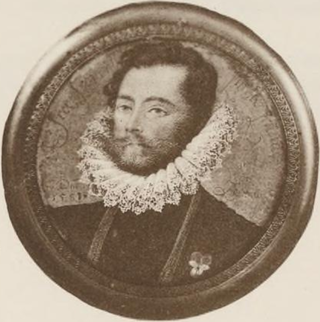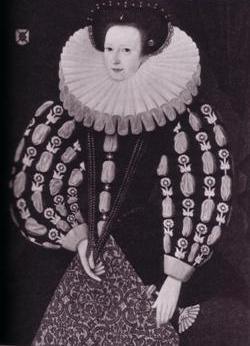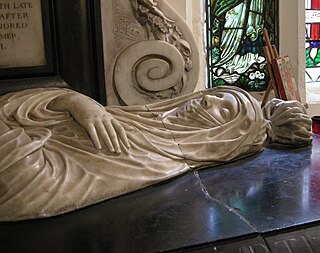


Valentine Cary (died 1626) (aliasCarey, erroneously Carew [1] ), was an English clergyman, who became Bishop of Exeter.



Valentine Cary (died 1626) (aliasCarey, erroneously Carew [1] ), was an English clergyman, who became Bishop of Exeter.
His origins are uncertain. He was born in about 1570 and is believed to have been an illegitimate son of Henry Carey, 1st Baron Hunsdon (1526–1596), [2] due to the known fact that he was born at Berwick-upon-Tweed and at about the time when Lord Hunsdon was stationed there in connection with his military duties. [3] This supposition therefore makes him an illegitimate brother of George Carey, 2nd Baron Hunsdon and of John Carey, 3rd Baron Hunsdon, whose son Henry Carey, 1st Earl of Dover, (and 1st Viscount Rochefort, 4th Baron Hunsdon) was the Bishop's patron by whose direct influence he was created Bishop of Exeter. [4] In his will he names the 4th Baron's daughter Judith Carey as his god-daughter, and bequeathed to Sir John Carey, the 4th Baron's son and heir apparent, the sum of £10 for a mourning ring. [5] He is known to have used the arms of the Carey family of Cockington and Clovelly in Devon (Argent, on a bend sable three roses of the field), of which the Barons Hunsdon were a junior branch, but added a bordure compony. [6]
He was a graduate of Christ's College, Cambridge, [7] and in 1591 was a Fellow of St John's College, Cambridge. [8]
A pluralist, Cary was vicar of East Tilbury in 1603, rector at Great Parndon 1606 to 1616, and was vicar of Epping Upland from 1607 to 1609. He was also rector of Orsett and Toft from 1610. [9] [10] [11]
In 1609/10, through the influence of his supposed half-brother John Carey, 3rd Baron Hunsdon (d.1617), [12] he became Master of Christ's College, where he had been a Fellow from 1597 to 1600. [13] [14] The election was bitterly contested, by the Puritan element. Cary was backed by the Lord Chancellor, Baron Ellesmere. [15] It led immediately to a confrontation between Cary and William Ames, who refused to wear the surplice, and who left Cambridge almost immediately. It also led Cary to be suspicious of Joseph Mede, who was to be one of Christ's best-known Fellows. [16]
He was later Dean of St. Paul's. In 1621 he was appointed Bishop of Exeter.
He died at his London townhouse in Drury Lane and was buried in Old St Paul's Cathedral, as he requested in his will should he die in London. [19] Any monument he may have had in St Paul's did not survive the Great Fire of London of 1666. His elaborate monument with effigy does however survive in Exeter Cathedral. [20]
{{cite web}}: CS1 maint: archived copy as title (link)
Sir Thomas Bodley was an English diplomat and scholar who founded the Bodleian Library in Oxford.

Baron Hunsdon is a title that has been created three times.

Henry Carey, 1st Baron Hunsdon,, was an English nobleman and courtier. He was the patron of the Lord Chamberlain's Men, William Shakespeare's playing company. The son of Mary Boleyn, he was a cousin of Elizabeth I.

The Cary family is an English aristocratic family with a branch in Ireland. The earliest known ancestor of the family is Sir Adam de Kari who was living in 1198. Sir John Cary purchased the Manor of Clovelly in the 14th century and established the family's status as members of the landed gentry. Various branches of the family were ennobled in the late 16th and early 17th centuries as Baron Hunsdon and Viscount Falkland.
MargaretSpencer (1472–1536) was the daughter of Sir Robert Spencer, of Spencer Combe in the parish of Crediton, Devon, by his wife Lady Eleanor Beaufort, the daughter of Edmund Beaufort, 2nd Duke of Somerset and Lady Eleanor Beauchamp.
Henry Carey, 1st Earl of Dover KB of Hunsdon, Hertfordshire was an English peer and Member of Parliament.

Mordecai Cary (1687–1751) was Bishop of Killala and Achonry.

Sir John Cary (or Carey) (c. 1491 – 1552), of Pleshey in Essex, was a courtier to King Henry VIII, whom he served as a Groom of the Privy Chamber, and of whom he was a third cousin, both being 4th in descent from John Beaufort, 1st Earl of Somerset (1371-1410).

Sir George Carey, JP, DL, of Cockington in the parish of Tor Mohun in Devon, England, was Lord Deputy of Ireland from May 1603 to February 1604.

Anne Morgan, Baroness Hunsdon was an English official. She was the wife of Henry Carey, 1st Baron Hunsdon, by whom she had a total of 13 children. On 14 December 1595, she was appointed by Queen Elizabeth I of England to the office of Keeper of Somerset House; a post which she held for life. She also served the Queen as a Lady of the Privy Chamber.
John Carey, 2nd Earl of Dover, styled Viscount Rochford from 1628 to 1666, was an English peer. He was the eldest son of Henry Carey, 1st Earl of Dover, and Judith, daughter of Sir Thomas Pelham, 1st Baronet. He was educated at St John's College, Cambridge.
John Carey, 3rd Baron Hunsdon was an English peer, politician and Governor of Berwick-upon-Tweed.

Lady Eleanor Beaufort, Countess of Ormond and Wiltshire was the daughter of Edmund Beaufort, 2nd Duke of Somerset (1406-1455), KG, and was a sister of the 3rd and 4th Dukes of Somerset.

Lady Elizabeth Berkeley, was an English courtier and patron of the arts.

Sir John Cary, of Devon, was a judge who rose to the position of Chief Baron of the Exchequer (1386–88) and served twice as Member of Parliament for Devon, on both occasions together with his brother, Sir William Cary, in 1363/64 and 1368/69.

Sir Robert Spencer "of Spencer Combe" in the parish of Crediton, Devon, was the husband of Eleanor Beaufort (1431–1501), the daughter of Edmund Beaufort, 2nd Duke of Somerset (1406–1455), KG, and was father to two daughters and co-heiresses who made notable marriages.

Sir William Cary (1437–1471) of Cockington and Clovelly in Devon was a member of the Devonshire gentry. He was beheaded after the defeat of the Lancastrians at the Battle of Tewkesbury in 1471.
The Manor of Clovelly is a historic manor in North Devon, England. Within the manor are situated the manor house known as Clovelly Court, the parish church of All Saints, and the famous picturesque fishing village of Clovelly. The parish church is unusually well-filled with well-preserved monuments to the lords of the manor, of the families of Cary, Hamlyn, Fane, Manners and Asquith. In 2015 the Rous family, direct descendants via several female lines of Zachary Hamlyn (1677–1759) the only purchaser of Clovelly since the 14th century, still own the estate or former manor, amounting to about 2,000 acres, including Clovelly Court and the advowson of the parish church, and the village of Clovelly, run as a major tourist attraction with annual paying visitor numbers of about 200,000.

Edward Cary or Carey or Carye was an English courtier and Master of the Jewel Office for Elizabeth I and James VI and I.
Joyce Denny (1507–1560) was an English courtier.